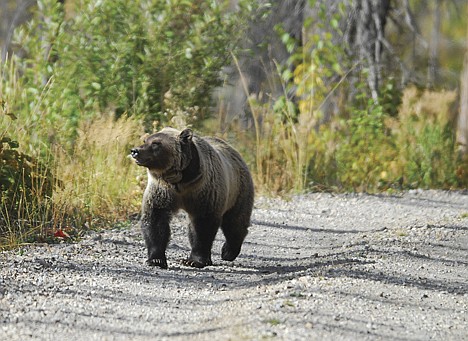Bears awake to plenty of spring green
Hungry bears are waking from their winter slumber and seeing a sight for sore eyes - the beginnings of spring green-up.
Kim Annis, bear management specialist for Montana Fish, Wildlife and Parks, predicts that the presence of ample foliage may cause fewer bear-human conflicts this spring.
"The last two years spring green-up was late, going into late May and early June because snow didn't melt off soon enough," Annis said. "Bears were hungry so they were getting into bird feeders and garbage left outside."
Though bears won't be so desperate for food this spring, Annis recommends that residents take measures to prevent bear problems by bringing in bird feeders and placing garbage in bear-proof containers or a secure shed.
Bears in the Kootenai National Forest begin to wake in late March to mid-April. Males have already begun to emerge and will be followed by lone females and, lastly, by females with dependent cubs.
"Several people have seen tracks of black bears and scat," Annis said. "They're starting to come out day-by-day. This rain will help bring them out as things start greening up."
Heavy snow may have led to a late spring green-up last year, but it also contributed to a good huckleberry crop last summer, which helped satisfy bear appetites.
"Bear conflicts were greatly reduced last year because bears had plenty to eat," Annis recalled, "but every year isn't a good berry year."
With a below-normal snowpack this winter, precipitation will play a big role over the spring and summer in determining the success of huckleberry crops.
"We didn't have a fantastic snow year, which means it may be dry up there if we don't get rain to compensate," Annis said. "We'll have to play the wait-and-see game. I think we'll have a very good spring."
Annis implores locals to call her if a bear begins to become a nuisance. She can offer her expertise and the use of loaner equipment, such as an electric fence and bear-proof garbage cans.
"Mostly importantly," she said, "if there's any bear activity going on around a house, call me ahead of time to see what I can do to help."
The sooner it is reported, the easier it will be to manage, Annis said. Bears that are rewarded with food from garbage cans, birdfeeders, pet food or barbecue grills can within days become habituated to looking for human food.
Annis can be reached at (406) 293-4161, ext. 207.
Grizzly bear to be relocated to Cabinets
Montana Fish, Wildlife and Parks plans to trap a young adult female grizzly bear in the North Fork or Flathead River area this year to release into the Cabinet Mountains, said the agency's bear management specialist, Kim Annis.
In order to meet the criteria, the potential bear must not have dependent cubs or a history of human conflicts.
The proposed transplant is part of an ongoing program to increase the Cabinet-Yaak grizzly population. An estimated 40 grizzlies inhabit the ecosystem, which encompasses more than 2,500 square miles in the Yaak River drainage and Cabinet Mountains.
The success of the plan will depend on whether a bear with the right specifications can be found, Annis said. In 2007, for example, FWP did not release any grizzlies into the Cabinets because the agency was unable to trap one that met its requirements. Two grizzlies were transplanted into the Cabinets in 2008 and one was released there last year.

